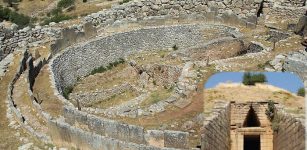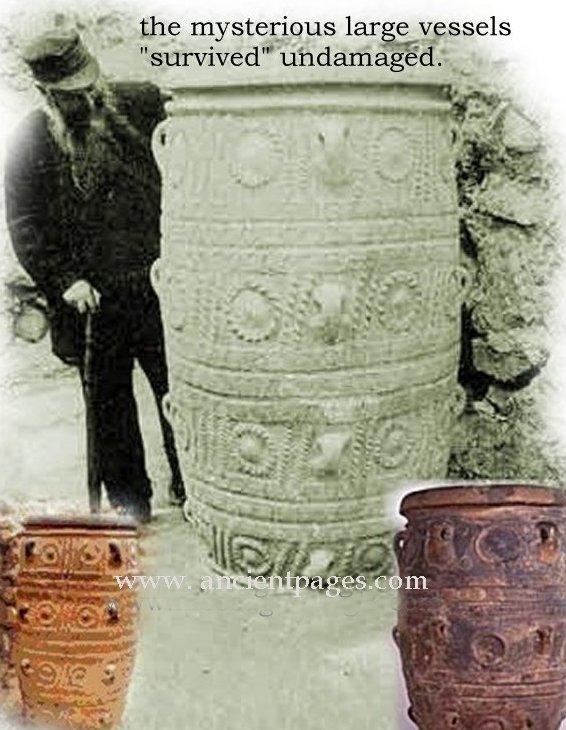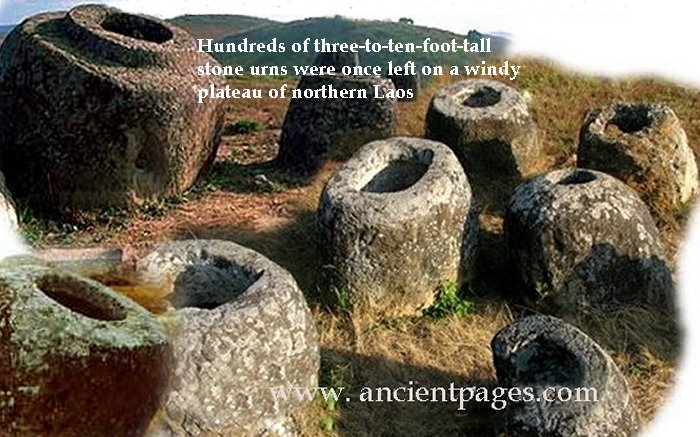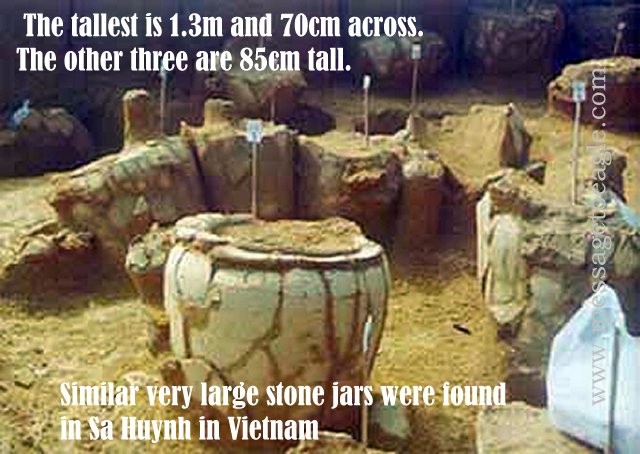Mysterious Gigantic Jars Of Unknown Origin Discovered Worldwide
A. Sutherland - AncientPages.com - Mysterious, gigantic jar-like artifacts were found in several places around the world, and in some places, their origins remain obscure. For what purpose were they created and by whom?
What kind of substance could have been stored in these vessels, made of stone - durable and strong material?
Not much is known about Ugarit in Syria, where mysterious jars were excavated. It is a place full of riddles.
As historical records say, Ugarit was destroyed by a mysterious catastrophe in the 14th century BC. "The royal city of Ugarit has been wasted by fire. Half the center is burnt, and the other half is no more.." Abimilki, king of Tyre wrote about the tragedy to the pharaoh Amenophis IV (Akhenaten).
What could cause such a great deal of damage and chaos of gigantic stone blocks? Some of them were hurled with enormous power for considerable distances. The havoc on this scale was definitely not caused by an earthquake. What kind of mysterious catastrophe turned large constructions into ruins and left the jars untouched, standing and waiting to be discovered?
Similar large (some over six feet tall) jars (pithoi), supposedly used for storing olive oil, wine, and cereals, were also found in the ruins of Knossos and Phaistos palaces in Crete. As ancient records say, the palaces were destroyed many times due to earthquakes and volcanic eruptions. Still the mysterious large vessels "survived" undamaged.
Both Knossos, Ugarit, and other great cities were destroyed at the same epoch and certainly not only by fire, which could not have been the only cause of the ruined massive walls and houses.
Who left hundreds of three- to ten-foot-tall stone urns scattered on a windy plateau of northern Laos?
The area is known as the Plain of Jars and is located in the Xiangkhoang Plateau, at about 1,000 meters above sea level in north-central Laos. Their origin also remains unknown, but they are supposed to be more than 2,000 years old.
How could these stones artifacts, some weighing as much as seven tons (!) arrive to this part of Laos? Also in this part of the world, it is said that the mysterious urns were used to store or make wine. No one knows, however, what was their original function.
Only one enormous jar - located at the site closest to town and often visited by tourists - has a carved relief of a human being with knees bent and arms reaching to the sky.
In the 1930s, French archeologist Madeline Colani discovered some jars that contained bronze and iron tools, and bracelets, along with cowry shells and glass beads, while the rest of them appeared to have been looted. Colani documented the jars in a 600-page monograph, "The Megaliths of Upper Laos", concluding that they were funerary urns carved by a vanished Bronze Age people.
This theory has been strengthened by the more recent discovery of underground burial chambers. Cremated remains found in the jars suggest that they were funerary urns used over 2,000 years ago.
"They are disposed of without regularity, some of them pressing one against another, others quite isolated. Each one is fashioned from a separate block of stone, and a small number of them are very well executed, as though turned on a lathe, bespeaking the hand of a true artist..." Colani wrote about the jars found at the site Ban Ang, approximately a mile northeast of the provincial capital of Xieng Khouang province, Ponsavan, located in the center of the Plain of Jars.
Excavations conducted in 1994, exposed the first anthropomorphic image recorded at the site of Ban Ang. On the side of one gigantic jar, there was a carved relief of a human figure with knees bent and arms reaching to the sky.
The Plain of Jars in central Laos is one of Southeast Asia's most mysterious prehistoric places. Approximately 90 sites scattered across miles of the plain contain thousands of gigantic stone jars, each weighing several tons.
No one was ever able to establish how these enigmatic artifacts got onto the plain, nor what purpose they once served. The theories regarding these structures range widely but despite many research efforts, no truly convincing explanation for their, centuries-long, existence was ever given.
And thus, the origin and reason for the Plain of Jars remain a mystery.
Similar very large stone jars were found in Sa Huynh in Vietnam and also in the North Cachar Hills of northeastern India, more than 600 miles to the northwest, had roughly the same design and dimensions as the urns in Laos.
"...Monolithic stone jars of the North Cachar hills... are clearly related and that pretty close to the stone jar necropolises of Vietnam, Celebes and Sumatra, and also no doubt to the monoliths of Dimapur and the latter group at Jamugari. The North Cachar Monoliths contained the ashes of the dead and bears a resemblance to stone cises and monoliths of Khasi Hills..." - G.P. Singh, "Historical Researches into Some Aspects of the Culture and Civilization of North-East India".
What human civilization had used these vessels in the household? In the area of today's Laos are whole fields dotted with such vessels.
Why were they made of stone? As we know, it is difficult to process this raw material. What was stored in such vessels and what could cause a breakdown of such powerful vessels?
Written by – A. Sutherland - AncientPages.com Senior Staff Writer
Copyright © AncientPages.com All rights reserved. This material may not be published, broadcast, rewritten or redistributed in whole or part without the express written permission of AncientPages.com
More From Ancient Pages
-
 Archaeologists Search For The Tomb Of Biblical Joshua At Khirbet Tibnah
Archaeology | Aug 5, 2022
Archaeologists Search For The Tomb Of Biblical Joshua At Khirbet Tibnah
Archaeology | Aug 5, 2022 -
 Has The Tomb Of The Real Santa Claus Been Found In Turkey?
News | Oct 5, 2017
Has The Tomb Of The Real Santa Claus Been Found In Turkey?
News | Oct 5, 2017 -
 On This Day In History: First Public And Free School Opened For Poor Children – On Sep 15, 1616
News | Sep 15, 2016
On This Day In History: First Public And Free School Opened For Poor Children – On Sep 15, 1616
News | Sep 15, 2016 -
 Glima – Ancient Martial Art Practiced By The Vikings Is Still Popular Today
Ancient Traditions And Customs | Mar 7, 2017
Glima – Ancient Martial Art Practiced By The Vikings Is Still Popular Today
Ancient Traditions And Customs | Mar 7, 2017 -
 Why Do Native Americans Often Wear Long Hair?
Ancient History Facts | Sep 19, 2019
Why Do Native Americans Often Wear Long Hair?
Ancient History Facts | Sep 19, 2019 -
 What Can Fossil Footprint Discoveries Tell Us About The Past?
Featured Stories | Aug 16, 2023
What Can Fossil Footprint Discoveries Tell Us About The Past?
Featured Stories | Aug 16, 2023 -
 Chocolate Was A ‘Hot Property’ In 17th Century England And There Were Rules For Safe Consumption
Featured Stories | Jun 27, 2018
Chocolate Was A ‘Hot Property’ In 17th Century England And There Were Rules For Safe Consumption
Featured Stories | Jun 27, 2018 -
 Ancient Town Pontefract, England Reveals Some Of Its Secrets
Archaeology | Mar 28, 2017
Ancient Town Pontefract, England Reveals Some Of Its Secrets
Archaeology | Mar 28, 2017 -
 Christian Church And Large House Unearthed In Ancient Laodicea, A Major Hub Of Christianity
Archaeology | Oct 31, 2020
Christian Church And Large House Unearthed In Ancient Laodicea, A Major Hub Of Christianity
Archaeology | Oct 31, 2020 -
 Mysterious Ancient Underground Chambers Beneath Jerusalem Baffle Archaeologists
Archaeology | Jul 6, 2020
Mysterious Ancient Underground Chambers Beneath Jerusalem Baffle Archaeologists
Archaeology | Jul 6, 2020 -
 Do Neanderthal Genes Determine Our Skin Color And Sleep Patterns?
DNA | Aug 1, 2023
Do Neanderthal Genes Determine Our Skin Color And Sleep Patterns?
DNA | Aug 1, 2023 -
 Mycenae Kingdom: Home To King Agamemnon And Tholos Tomb ‘Treasure of Atreus’
Civilizations | Jun 11, 2022
Mycenae Kingdom: Home To King Agamemnon And Tholos Tomb ‘Treasure of Atreus’
Civilizations | Jun 11, 2022 -
 Controversial “Life Of St. Issa” Scroll Reveals Jesus Spent Several Years In India And Tibet
Ancient Mysteries | Nov 4, 2014
Controversial “Life Of St. Issa” Scroll Reveals Jesus Spent Several Years In India And Tibet
Ancient Mysteries | Nov 4, 2014 -
 51,000-Year-Old Bone Carving Shows Neanderthals Were Artistic Long Before Humans Arrived
Archaeology | Jul 6, 2021
51,000-Year-Old Bone Carving Shows Neanderthals Were Artistic Long Before Humans Arrived
Archaeology | Jul 6, 2021 -
 Rare 1,800-Year-Old Fragment From Fish-Shaped Roman Bottle Unearthed In Gloucestershire
Archaeology | Jul 23, 2019
Rare 1,800-Year-Old Fragment From Fish-Shaped Roman Bottle Unearthed In Gloucestershire
Archaeology | Jul 23, 2019 -
 Mystery Of Biblical Adam – A Hidden Story Within A Story Open To Interpretation
Ancient Mysteries | Jan 18, 2018
Mystery Of Biblical Adam – A Hidden Story Within A Story Open To Interpretation
Ancient Mysteries | Jan 18, 2018 -
 Who Built Massive Astronomically Oriented Buildings In The Most Ancient Times?
Civilizations | Nov 27, 2018
Who Built Massive Astronomically Oriented Buildings In The Most Ancient Times?
Civilizations | Nov 27, 2018 -
 What Female Jobs Could Lead To Being Accused Of Witchcraft In Early Modern England?
News | Sep 20, 2023
What Female Jobs Could Lead To Being Accused Of Witchcraft In Early Modern England?
News | Sep 20, 2023 -
 Suprising Discovery Of A Well-Preserved Ancient Roman Road In London, UK
Archaeology | Nov 19, 2024
Suprising Discovery Of A Well-Preserved Ancient Roman Road In London, UK
Archaeology | Nov 19, 2024 -
 On This Day In History: Ramesses II Became Pharaoh Of Ancient Egypt – On May 31, 1279 BC
News | May 31, 2016
On This Day In History: Ramesses II Became Pharaoh Of Ancient Egypt – On May 31, 1279 BC
News | May 31, 2016




